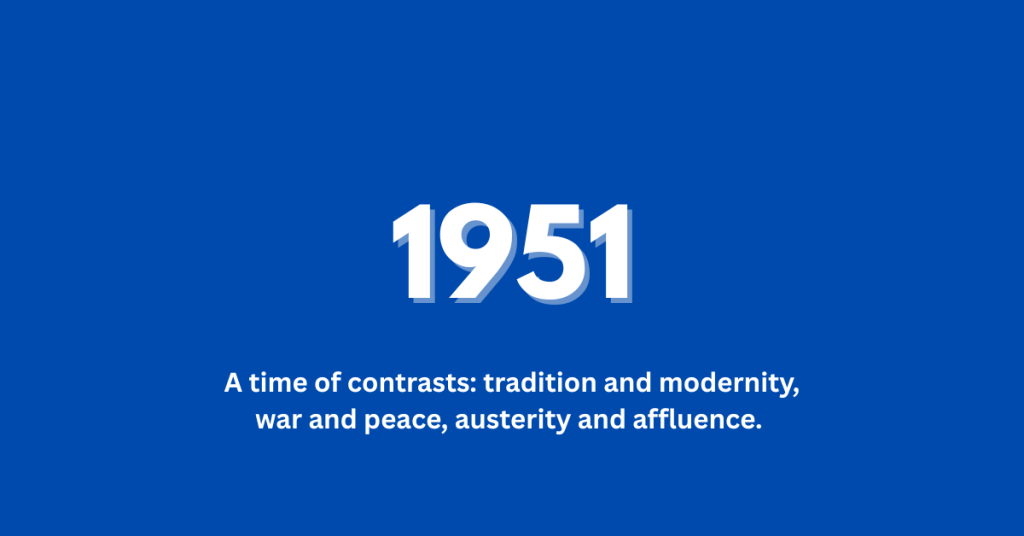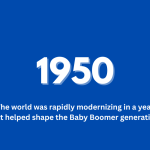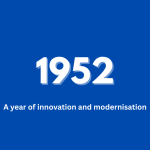What Happened in 1951 proved to be a year of transition and recovery. The Second World War had ended six years earlier, but its legacy continued to shape global affairs. In Britain, the Festival of Britain offered a glimpse of optimism and modern design, even as rationing and political shifts persisted. Globally, the Cold War intensified, and a new era of culture, technology, and mass media began to take hold. It was a year of both contrast and creativity—marked by atomic tension on one hand and the birth of rock and roll on the other.
World Events
- Apr 18 – The European Coal and Steel Community is established, laying the groundwork for the future European Union.
- Jul 10 – Ceasefire negotiations begin to end the Korean War, which had started the year before.
- Sep 1 – The ANZUS treaty is signed, a defence pact between Australia, New Zealand, and the United States.
- Sep 8 – The Treaty of San Francisco is signed by 48 nations, formally ending WWII with Japan.
- Dec 24 – Libya gains independence from Britain and France, becoming the United Kingdom of Libya.
- Iran nationalises its oil industry, sparking conflict with the UK and setting the stage for future upheaval.
- The first direct-dial long-distance telephone call is made in the U.S.
- The Cold War continues to dominate global politics, with tensions rising in Asia and Europe.
What happened in 1951 in the United Kingdom
- May – King George VI opened the Festival of Britain on the South Bank in London.
- Winston Churchill returns to power after winning the general election in October.
- Rationing continues, but new consumer goods slowly reappear.
- Construction of new towns and council housing continues to address post-war shortages.
What happened in 1951 in the United States
- President Truman is midway through his second term, focused on containment of communism abroad.
- The U.S. tests its first thermonuclear device, escalating the arms race.
- American culture continues to spread globally via film, music, and television.
- The term “Rock and Roll” begins to appear in music press and radio.
Popular culture in 1951: Fashion, Film, TV and Music
- The Festival of Britain becomes a showcase for British post-war innovation.
- Colour television broadcasting begins in the U.S. (on a limited basis).
- The Miss World competition is held for the first time in London.
- The first UK pedestrian crossing with Belisha beacons is introduced in Slough.
- Super glue is refined and gains attention for its powerful adhesive properties.
Film and Television – What people were watching in 1951
Notable Films Released:
- A Streetcar Named Desire
- The African Queen
- The Day the Earth Stood Still
- The Lavender Hill Mob
- Strangers on a Train
- An American in Paris
- Alice in Wonderland (Disney)
- Scrooge (Alastair Sim)
Television Highlights:
- The BBC continues expanding programming.
- What’s My Line? debuts in the UK.
- The U.S. TV audience grows rapidly, with shows like I Love Lucy in production.
Music – What people listened to in 1951
Popular Songs and Artists:
- “Too Young” – Nat King Cole
- “Because of You” – Tony Bennett
- “Cold, Cold Heart” – Hank Williams
- “Cry” – Johnnie Ray
- “Unforgettable” – Nat King Cole
- “How High the Moon” – Les Paul & Mary Ford
- “Be My Love” – Mario Lanza
- “Mockin’ Bird Hill” – Patti Page
- “Come On-A My House” – Rosemary Clooney
- “The Thing” – Phil Harris
Sports
- Wimbledon Champions:
- Men’s Singles: Dick Savitt (USA)
- Women’s Singles: Doris Hart (USA)
- Tottenham Hotspur win the Football League First Division.
- The first Pan American Games are held in Buenos Aires, Argentina.
- Juan Manuel Fangio wins the Formula One World Championship.
What happened in 1951 in the motoring world
- Car production ramps up as post-war restrictions ease.
- Demand for personal transport increases across Britain and Europe.
- The Morris Minor and Ford Popular remain common sights on UK roads.
New Car Models Introduced:
- Austin A30 (prototype)
- Jaguar C-Type (racing car)
- Renault Frégate
- Chrysler Imperial
- Studebaker Commander
- Hudson Hornet
- Nash-Healey
Inventions and Breakthroughs in 1951
- Super Glue – Refined and introduced commercially.
- Direct-Dial Long-Distance Calling – First used in the U.S., marking a major telecom leap.
- UNIVAC I – The first commercial computer designed for business use is completed.
- Nuclear Fusion Research – The U.S. tests a thermonuclear device, accelerating Cold War science.
- Colour TV Broadcasting – Begins experimentally in the United States.
- The Pill – Developed by Luis Miramontes in Mexico; the world’s first oral contraceptive.
- Mass production of penicillin and streptomycin reaches record levels.
- Tupperware parties – A new model of home-based social marketing begins to take off.
Looking Back
1951 was a year that looked both backward and forward. Britain honoured its past while celebrating progress with the Festival of Britain. Globally, the Cold War loomed larger, but so did the innovations that would define the second half of the 20th century—nuclear energy, colour television, and the first seeds of rock and roll. It was a time of contrasts: tradition and modernity, war and peace, austerity and affluence—all existing side by side in a world still finding its feet.
Whatever your memory, this was a year of innovations pointing to a brave new world.
→ Feel free to share your memories or thoughts in the comments below!



